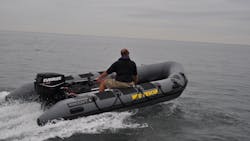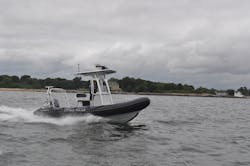Boats on the Go
Matthew Velluto, Vice President of Sales and Marketing at RIBCRAFT, recently spoke to OFFICER Magazine about the benefits of fully inflatable boats and how they help agencies conduct search and rescue operations in remote and wilderness areas.
This article appeared in the September issue of OFFICER Magazine. Click Here to view the digital edition. Click Here to subscribe to OFFICER Magazine.
The Massachusetts-based company manufactures boats specifically for law enforcement, first responders, military agencies and marine professionals. The company offers boats that range in size from 14 feet, all the way up to 41 feet and builds boats for the U.S. Navy for explosive ordinance work as well as 11-Meter Expeditionary Mine Counter Measure boats and 7-Meter shipboard rigid inflatable (RIB) boats.
“We take that experience and apply it at the state and local level for police and sheriffs so that they have something that is mission-specific around their operational requirements as opposed to just taking a regular boat that is built for fishing or built for recreational enjoyment and then putting that into service,” he says.
RIBCRAFT mainly specializes in RIB boats, which consists of a fiberglass hull, deck and console with the sides of boat made from an inflatable tube. RIB boats have a much deeper V hull shape than traditional boats and are able to take on rougher waters.
RIBCRAFT’s AF Series of fully inflatable boats are primarily used for search and rescue applications. They tend to be used in areas where there is more shallow water because unlike the rigid inflatable boats, they don’t have a deep-V hull and are relatively flat on the bottom. “They can float in about six to eight inches of water,” says Velluto. “They tend to be used for tactical operations and SWAT operations where you need to get into very shallow water when approaching a beach or marshlands. Because they are lightweight, if you are using it in a river area, you can easily pick it up with three to four people.”He says that one of the biggest benefits is that fully inflatable boats can be deployed, if needed, by hand. “They are definitely used by agencies that are going into remote areas that don’t have roads or where you can tow a bigger boat on a trailer and back it into the water,” he says. “It really has to do with the size and the access to those bodies of water. Rivers, ponds and lakes in remote areas where you either don’t have roads or you don’t have launching facilities, that’s where they come in handy.”
Fully inflatable boats are quite stripped down for weight concerns and don’t include much electrical technology. “If you are using a boat like this, for the most part you’re looking for portability,” he says. “You’re not putting a lot on there. Even the engines tend to be smaller because, quite frankly, the engines are really heavy. You aren’t necessarily looking for speed, unless you are using it as a tactical type of boat.”
When deflated, the fully inflatable boats can be as small as around four feet long by about three feet wide and haul in the bed of a truck or in a trailer. A manual foot pump takes about 25 minutes to inflate a fully inflatable boat, but a compressor can be used as well. The inflatable series tends to be more standardized than RIBCRAFT’s rigid inflatable boats. “It just comes down to size requirements in terms of what the department is looking to carry in terms of personnel or potential equipment and those types of things.”
The boats can be used by agencies for basic law enforcement operations including patrol, enforcement, tactical operations and search and rescue missions. “Pretty much anything that would happen on the water, we can provide a boat that would allow people to get out there and do their job,” says Velluto.
This article appeared in the September issue of OFFICER Magazine.

Paul Peluso | Editor
Paul Peluso is the Managing Editor of OFFICER Magazine and has been with the Officer Media Group since 2006. He began as an Associate Editor, writing and editing content for Officer.com. Previously, Paul worked as a reporter for several newspapers in the suburbs of Baltimore, MD.





